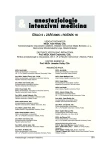The training of military anaesthetists for mass casualties, 1960–1980
Authors:
J. Pokorný
Published in:
Anest. intenziv. Med., 16, 2005, č. 5, s. 265-267
Category:
From History
Overview
Thanks to their successful post-war efforts, Czech pioneers of anaesthesiology led by L. Spinadel achieved the recognition of anaesthesiology as a higher medical specialization, published in the decree of Ministry of Health ‘On the Professional Education of Physicians’ No. 258/1952. In this document the administration of anaesthesia was declared a medical procedure, whereas until then it had been delegated by the surgeons mostly to nurses or even to trained orderlies. Following this, the Army Medical Service was requested to train a sufficient number of physicians able to anaesthetise in field conditions. From the late fifties the anaesthetic departments of all army hospitals organized two-month courses for reserve medical officers of selected specializations (paediatrics, dentistry), training non-anaesthetic physicians to become ‘physicians with erudition in anaesthesiology’, recognised as an individual military medical specialization and differentiated from specialists in anaesthesiology. These physicians were assessed and could be placed according to their erudition to the field medical units. In this way the Army Medical Administration solved the existing disproportion between the number of specialized anaesthetists and the existing need to provide adequate surgical care for mass casualties.
Thanks to the measures described above the civilian health care system gained a group of several hundred physicians who not only became acquainted with the basics of general anaesthesia during military field-exercises, but who also got trained in carrying out important life saving procedures such as endotracheal intubation, mechanical ventilation, IV access and fluid therapy. Thus a significant number of physicians became much better prepared for providing medical first aid in any life-threatening situation.
Key words:
mass casualties – physician with erudition in anaesthesiology – licence for physicians of the EMS
Labels
Anaesthesiology, Resuscitation and Inten Intensive Care MedicineArticle was published in
Anaesthesiology and Intensive Care Medicine

2005 Issue 5
Most read in this issue
- Curare: Alternative methods of administration
- Curare: Some historical facts
- Development in anaesthetic technique in the extremely low weight infant, 1998–2003
- The Czech contribution to the advance in the interpretation of acid-base disturbances
